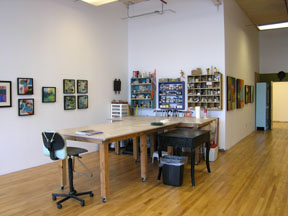 |
| Joan Mitchell, 1991 |
 |
| Lee Krasner, 1973 |
I debated what to call this post. Should it be Two Strong Women? Two Women Painters? Two Biographies of Women Artists? Or maybe Two Art Icons? As you can see, I finally decided to avoid gender and focus on genre in the title, but gender plays an important part in their personal histories as well as their places in art history.
 |
| Krasner, Milkweed, 1955 |
What brings these two painters together in this post is that I just finished reading the two recent biographies about them: Joan Mitchell: Lady Painter by Patricia Albers and Lee Krasner: A Biography by Gail Levin. I strongly recommend both of these books. That's not to say that they are easy going; they demand commitment on the part of the reader because they are filled with detail - people, paintings, problems, successes, failures - all the things that make up full lives of artists. But they do a good job of presenting the personalities of Mitchell and Krasner - both strong and opinionated women, who struggled with relationships with men in their lives as well as trying to continue making their own work and carving out a place for themselves in the patriarchal art world.
 |
| Joan Mitchell, City Landscapes, 1955 |
Lee Krasner was 17 years older than Joan Mitchell (Krasner born 1908, Mitchell born 1925) but they were both part of the Abstract Expressionist painting scene in New York during the 1950s. Krasner, of course, was married to Jackson Pollock and moved out of Manhattan with him to Springs (East Hampton) on Long Island in the mid-1940s. Mitchell moved to France in the mid-1950s to be with her lover, artist Jean-Paul Riopelle, and lived there for the rest of her life.
 |
| Mitchell, untitled, 1960 |
I can't recap their lives except to say that if they had been men, their lives as artists would have been a hell of a lot easier and they would have received the recognition they deserved. As it was, they had to fight so strongly for everything that it gave them both a hard edge and a cynical attitude toward life. Abuse of alcohol played an important part in both of their lives: for Mitchell, it was her own over-consumption, while Krasner spent years of her life coping with and trying to manage Pollock's alcoholism. Once Pollock had perished at age 44 in a drunk driving accident, Krasner was free to pursue her own career, but she was always under Pollock's long shadow, on guard against comparisons of her work to his as well as trying to fend off those who tried to gain control of his work by approaching hers.
Both Mitchell and Krasner died at fairly young ages (Mitchell at 66 and Krasner at 75) and had painful ends. Krasner suffered from rheumatoid arthritis and diverticulitis. Mitchell had cancer of the jaw and lung cancer. I can't help thinking that their struggle to prove themselves and continually battle against those who minimized or failed to recognize their artistic achievements wore them down.
 |
| Krasner, The Seasons, 1957 |
One major note about both these artists is their legacy to artists of the future. They both established foundations to benefit artists in need. In fact, I was the recipient of a generous grant from the Pollock-Krasner Foundation in 1995 and that validated my art career to me as nothing else had. It made a very definite improvement in my life. The Joan Mitchell Foundation also awards grants to painters and sculptors annually and funds art education for New York City youth. Not to start a gender battle, but how many male artists established such foundations to benefit artists and make a lasting investment in the future?
New York Gallery representation: Lee Krasner - Robert Miller Gallery, Joan Mitchell - Cheim & Read
Pollock Krasner House & Study Center (great website)



























